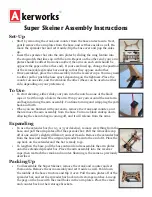Summary of Contents for 885-403
Page 1: ...Product Code 885 403 ...
Page 48: ......
Page 49: ...Product Code Código de producto 885 403 ...
Page 96: ...English Spanish 885 403 Printed in China XE7071 3013 ...
Page 1: ...Product Code 885 403 ...
Page 48: ......
Page 49: ...Product Code Código de producto 885 403 ...
Page 96: ...English Spanish 885 403 Printed in China XE7071 3013 ...

















